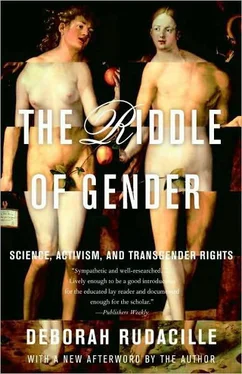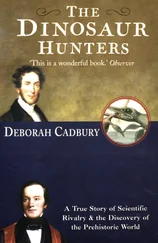In his journal, Abel predicted that after his death his anomalous body would become a teaching tool and an exemplar of oddity. “When that day comes a few doctors will make a little stir around my corpse; they will shatter all the extinct mechanisms of its impulses, will draw new information from it, will analyze all the mysterious sufferings that were heaped up on a single human being.” This premonition was fulfilled as Abel’s body was autopsied and the genitals and internal organs probed, studied, and sketched for the edification of future physicians pondering the riddle of “hermaphrodites,” individuals whose bodies did not conform to traditional notions of male and female anatomy.
Though the Chevalier d’Eon and Abel Barbin are perhaps the best-known cases of presurgical “sex changes” in Western history, physically intersexual people such as Herculine Barbin and neurologically intersexual people such as the Chevalier d’Eon have always existed. Gender variance thus appears to be a “natural” phenomenon, an example of biological diversity. Professor Milton Diamond of the University of Hawaii, who has studied the phenomenon of intersexuality for more than half a century, argues persuasively that gender variance should be considered neither an anomaly nor a pathology, but a simple variation. “Variety is Nature’s way,” he told an audience at the International Foundation for Gender Education (IFGE) in March 2003. “How many of us in this room are the same height, weight? We’re all part of a great experiment.” Unfortunately, society doesn’t view gender variance with the same benevolence that it views differences in height and (less benevolently today) weight. “Difference is a dirty word to many,” Diamond pointed out.
As contemporary historians and writers have worked to uncover the hidden history of homosexuality, some long-dead individuals who adopted cross-gendered dress and lifestyles have been lauded as gay pioneers. The most famous such case is that of Alan Hart (nee Alberta Lucille), a Portland physician who began living as a man after a hysterectomy in 1917. The historian Jonathan Ned Katz identified Hart on the basis of a case study published by the physician who oversaw, and encouraged, Hart’s metamorphosis. Katz and the larger gay community promptly proclaimed Hart (who was married to a woman) a lesbian pioneer, and explained Hart’s decision to live as a man as an accommodation to social prejudices and coercion by a homophobic physician.
Among gays as well as straights, the complex relationship between sexual orientation and gender identity has thus sometimes been reduced to a simple formula with four variables: male or female, gay or straight. This perspective is shared by members of the (straight) public who believe that a man who wears dresses can’t possibly be heterosexual, even if he sleeps with women only, just as some gay Americans believe that a female-bodied person who dresses like a man must be a masculine lesbian. Both gays and straights have a hard time believing that both of these individuals might in fact be heterosexual men. That idea challenges everything that we think we know about sex, gender, and sexual orientation. “Some men are born in female bodies,” said Katherine (Kit) Rachlin—a clinical psychologist who has worked with transgendered clients for more than fifteen years—at a conference I attended while beginning research on this book. Like many Americans, gay and straight, I received this statement with certain skepticism. But after having met numerous men born in female bodies and women born in male bodies, I no longer doubt that it is true.
Sexual orientation is invisible, but gender identity is difficult to hide. It’s evident in the way we walk, the way we talk, the way we dress, the way we cut our hair. My identity as a woman is clearly visible in hundreds of small and large ways. When you pass me on the street, your brain registers my long hair, makeup, skirt, pocketbook, and painted nails, and renders the verdict “female.” Even if I cut my hair short, skipped makeup, and wore jeans and a T-shirt, you would still identify me as a woman by my physique, by my gait, and by the way I related to you, my fellow pedestrian, as I walked by. But what if, when you passed me on the street, you felt a moment of confusion? What if you felt it necessary to turn around and stare at me as I walked away from you? What if you turned to your companion and said, “Was that a guy or a girl?” Would you be reacting to sexual orientation or gender expression?
Many people infer the former from the latter, and believe that “masculine” women and “feminine” men are invariably gay. Feminine males and masculine females are often subject to scorn and derision, as anyone who has spent time on a playground can testify. A boy who rejects rough play and sports, who walks or talks in a way considered effeminate by his peers, is verbally and sometimes physically abused. The rules for girls are a bit looser in childhood. But by middle school, girls who are deemed inappropriately masculine by their peers are also teased and harassed. These prejudices carry through into adult life, and the all-purpose word used by many people to enforce gender conformity is “gay”—even when they are referring not to the person’s choice of partner, but to the way he or she expresses gender. It is worth noting that though an increasing number of cities and states have added “sexual orientation” to civil rights legislation, fewer have added riders protecting people whose gender expression makes them targets of discrimination or violence. This lapse is a sign of our continuing failure to understand and acknowledge the distinction between sexual orientation and gender identity, and it has major consequences.
Julian Weiss, an attorney who has published several articles about the legal issues confronting transgendered and transsexual people, notes that “gender identity is subject to scrutiny in a way that sexual identity [orientation] is not.” The letter M or. F affixed to one’s birth certificate “publicly identifies us in every area of life, whether it be a license to drive or conduct business, proof of citizenship required to obtain employment, a benefit program such as social security, or filing of income taxes.” Biological sex (and therefore gender identity) is thus regulated by the state in a way that sexual orientation is not. Citizens of the United States and most other nations are not required to announce their sexual orientation or to affirm it in legal documents. If you are a woman who decides to begin sleeping with women, it is no one’s business but your own. But if you (a female-bodied or intersexual person assigned as female at birth) decide that you are a man and wish to live and be recognized as a man in the world, then you must petition the authorities to approve that change. In effect, you must ask the state’s permission to live as a man—and present a legitimate (medical) reason for your desire to do so.
Law is based on custom. Deeply rooted assumptions about our bodies keep us locked into the belief that there are only two sexes—male and female—and that the sex of the body is always consistent with the sex of the brain. The equations work like this: Born with a vagina, female. Born with a penis, male. It seems incomprehensible that a child born with a penis could grow up with the certain knowledge that she is a girl, or that a child born with a vagina could be equally convinced that he is a boy. Many people are unwilling to accept that “the hands of God” or Nature could have fashioned human beings whose sense of self is at war with their flesh, or whose gender identity falls somewhere in between the poles of male and female.
Because we live in a culture that expects science to settle questions based in the body, we look to science to tell us what it means to be male and female, how gender identity is formed, and why it is that the sex of the body sometimes seems to be at odds with the sex of the mind. But despite our sophisticated tests, science can still offer no definitive answer to this question, only tantalizing clues. When the governments of England and France attempted to solve the riddle of the Chevalier d’Eon’s sex, they called in two doctors to examine the chevalier’s body. From the evidence of their eyes (the chevalier appeared to have breasts), the doctors concluded that a woman stood before them. Only at death were the chevalier’s genitals examined, and they told a different story. Today our tools are vastly more powerful, yet they are no more accurate in predicting gender identity in certain cases than the eyeball test that established the Chevalier d’Eon’s or Herculine Barbin’s anatomical sex.
Читать дальше












